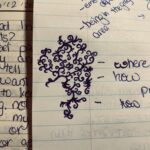
How do we think?
Exploring the ways people think is certainly not a new question, but it has fascinated and baffled psychologists for decades.
Until the 1980s, psychologists and linguists believed that language was the primary mode of thought. Linguists Edward Sapir and Benjamin Lee Whorf developed the Sapir-Whorf hypothesis in 1959, proposing that language doesn’t just help people express their thoughts but it also influences their worldviews and biases.
However, recent studies have shown that’s not necessarily the case—humans rely on both visual and verbal modes of thought.
A 2017 study says that these two modes of thought may be independent of each other. Individuals seem to have better control over their inner speech when they are deliberately thinking verbally, but invoke visual representations during both modes of thought.
In other words, the participants were more likely to have a “voice-over”—an internal monologue—accompanied by some visual imagery. But if they were asked to visually imagine something, the process would be less likely to have a voice-over. Even when people deliberately attempt to think verbally, visual thinking almost always intrudes.
Psychologists say that some people engage primarily in visual thinking and are able to think in pictures, like a slideshow. This includes being able to construct or rotate images, organize ideas graphically and have spatial awareness.
People who think mainly in pictures are also known to experience abstract thoughts that need to be verbalized before being fully formed. They tend to require more time to express their thoughts when responding to a question.
Harvard psychologist Maria Kozhevnikov has a hypothesis that suggests people who think visually also rely on two distinct skill sets: object visualization and spatial visualization.
Object visualization is the ability to picture sceneries in detail, while spatial visualization is the ability to estimate and measure distances, dimensions and apply numbers physically.
The human brain is wired to understand pictures quicker than processing words or text. That’s why tools like infographics, charts, drawings and mind-maps are helpful in presentations or lectures.
People with verbal thought processes think about information in words and sentences. Those who are good at this type of thinking are often average when it comes to spatial visualization skills, but evidence has suggested that there is no single or defined visual thinking style.
In her book Rethinking Thought, Laura Otis, neuroscientist and professor of interdisciplinary studies at Emory University, says that the cognitive categories of visual and verbal were meant to oppose each other in the late 20th century. But Otis’ research finds that these categories are far more complex. They do not exist only as black-and-white distinctions, but as co-existing processes with grey areas in between.
The ability to have an internal monologue is thought to have developed in early childhood. As a child acquires language skills, they also learn to engage and interact with their own internal narrative. After a certain point in their childhood, they learn to shape their visual thoughts and verbalize them.
In her article on Psychology Today, Otis says that researchers can study verbal and visual thinking through lab experiments and interview-based studies. However, it’s equally important to keep in mind that every individual has their own account of the way their mind works.
About the author
Khaleda is a former reporter for Youth Mind. If she's not daydreaming of owning a bookstore cafe, she's most likely pining over pretty classic book covers.







